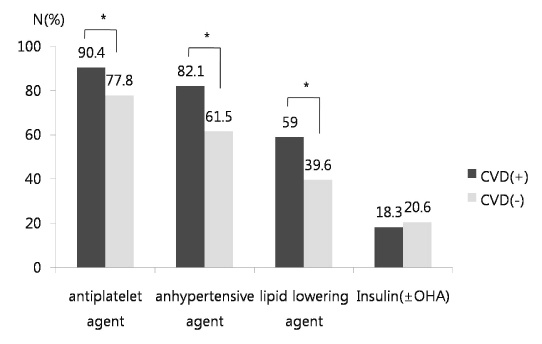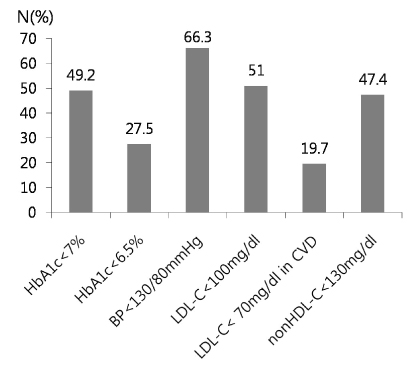Korean Diabetes J.
2009 Jun;33(3):241-250. 10.4093/kdj.2009.33.3.241.
The Current Status of Type 2 Diabetes Management at a University Hospital
- Affiliations
-
- 1Department of Internal Medicine, Dongguk University College of Medicine, Gyeongju, Korea. ysbae28@medimail.co.kr
- KMID: 2222424
- DOI: http://doi.org/10.4093/kdj.2009.33.3.241
Abstract
- BACKGROUND
The prevalence of type 2 diabetes has increased worldwide, as have the incidence and mortality of associated cardiovascular complication. However current status of diabetes management is poor. This study was performed to evaluate the management of care for type 2 diabetes patients at a university hospital. METHODS: This study comprised 926 type 2 diabetes patients, over the age of 30, who were treated at the Dongguk University Gyeongju Hospital between January and December 2008. Medical records were reviewed to collect demographic information, biochemical test results and the pharmacologic agents prescribed. RESULTS: The mean age, duration of diabetes and body mass index were 62.5 +/- 11.8 years, 9.1 +/- 7.2 year and 24.7 +/- 6.3 kg/m2, respectively. There were 251/926 (27.1%) patients with cardiovascular disease. In addition, 49.2% and 27.5% of patients had HbA1c levels < 7% and < 6.5%, respectively. There were 66.3% of the patients with blood pressure < 130/80 mm Hg. Fifty one percent and 47.4% of the patients had an LDL-C < 100 mg/dL and a non-HDL-C < 130 mg/dL, respectively. In addition, 19.7% of the patients with cardiovascular disease had an LDL-C < 70 mg/dL. Antiplatelet agents were used in 81.2% of the patients. The mean number of HbA1c measurements was 1.07 +/- 0.7 /year. HbA1c and lipid profiles were not checked in 21.4% and 23.1% of the patients, respectively. Over the previous six months, 6.9% of the patients had not had their blood pressure monitored. CONCLUSION: Among the patients with type 2 diabetes evaluated, 30~70% received in inadequate level of care. These findings point to the need for more aggressive efforts for optimal metabolic control.
MeSH Terms
Figure
Reference
-
1. Rhee BD. Epidemiological characteristics of diabetes mellitus among Korean population. J Korean Diabetes Assoc. 2003. 27:173–179.2. Cho NH. Prevalence of diabetes and management status in korean population. The Korean Journal of Internal Medicine. 2005. 68:1–4.3. Zimmet P, Alberti KG, Shaw J. Global and societal implications of the diabetes epidemic. Nature. 2001. 414:782–787.4. Barr EL, Zimmet PZ, Welborn TA, Jolley D, Magliano DJ, Dunstan DW, Cameron AJ, Dwyer T, Taylor HR, Tonkin AM, Wong TY, Mcneil J, Shaw JE. Risk of cardiovascular and all-cause mortality in individuals with diabetes mellitus, impaired fasting glucose, and impaired glucose tolerance: the Australian Diabetes, Obesity, and Lifestyle Study (AusDiab). Circulation. 2007. 116:151–157.5. United Kingdom Prospective Diabetes Study Group (UKPDS). Intensive blood-glucose control with sulfonylureas or insulin compared with conventional treatment and risk of complications in patients with Type 2 diabetes (UKPDS33). Lancet. 1998. 352:837–853.6. Holman RR, Paul SK, Bethel MA, Matthews DR, Neil HA. 10-year follow-up of intensive glucose control in type 2 diabetes. N Engl J Med. 2008. 359:1577–1589.7. Gaede P, Vedel P, Larsen N, Jensen GV, Parving HH, Pedersen O. Multifactorial intervention and cardiovascular disease in patients with type 2 diabetes. N Engl J Med. 2003. 348:383–393.8. Gaede P, Lund-Andersen H, Parving HH, Pedersen O. Effect of a multifactorial intervention on mortality in type 2 diabetes. N Engl J Med. 2008. 358:580–591.9. Korean Diabetes Association. Treatment of guideline for diabetes. 2007. 1st ed. seoul: MMK communications;39–112.10. American Diabetes Association. Standards of medical care in diabetes. Diabetes Care. 2009. 32:suppl 1. S13–S61.11. IDF Clinical Guidelines Task Force. Global Guideline for Type 2 Diabetes: recommendations for standard, comprehensive, and minimal care. Diabet Med. 2006. 23:579–593.12. Park SW, Kim DJ, Min KW, Baik SH, Choi KM, Park IB, Park JH, Son HS, Ahn CW, Oh JY, Lee JY. Current status of diabetes management in korea using national health insurance database. J Korean Diabetes Assoc. 2007. 31:362–368.13. Lim DJ, Kwon HS, Kim HS, Lee JH, Ko SH, Lee JM, Kim SR, Lee WC, Son SH, Cha BY, Lee KW, Son HY, Kang SK, Yoon KH. Clinical characteristics of the diabetic patients managed at the different medical institutions in seoul and gyeonggi province. Journal of Internal Medicine. 2006. 71:173–181.14. Rhee SY, Kim YS, Oh SJ, Choi WH, Park JE, Jeong WJ. Diabcare Asia 2001-Korea: Country report on outcome data and analysis. Korean J Intern Med. 2005. 20:48–54.15. Kim SA, Park WS, Ohrr HC, Kang HY, Lee DH, Yi SW, Kwak YH, Song JS. Prevalence and management status of diabetes in Korea. Korean J Med. 2005. 68:10–17.16. Expert Panel on Detection, Evaluation, and Treatment of High Blood Cholesterol in Adults. Executive summary of the third report of the national cholesterol education program (NCEP) expert panel on detection, evaluation, and treatment of high blood cholesterol in adults (Adult Treatment Panel III). JAMA. 2001. 285:2486–2497.17. Stone NJ, Bilek S, Rosenbaum S. Recent National Cholesterol Education Program Adult Treatment Panel III update: adjustments and options. Am J Cardiol. 2005. 96:53E–59E.18. Earl SF, Chaoyang L, Randie RL, Ali HM. Trends in A1C concentrations among U.S. adults with diagnosed diabetes from 1999 to 2004. Diabetes Care. 2008. 31:102–104.19. Mohamed M. Diabcare-Asia 2003 Study Group. An audit on diabetes management in Asian patients treated by specialists: the Diabcare-Asia 1998 and 2003 studies. Curr Med Res Opin. 2008. 24:507–514.20. Park JH, Kim KW, Kang EJ, Kim TY, Lee SR, Bae SC, Kim MK, Choi SY, Park JH. Evaluation of glycemic control in type 2 diabetic patients have been treated in general hospital. J Korean Diabetes Assoc. 2004. 28:208–218.21. Hoerger TJ, Segel JE, Gregg EW, Saaddine JB. Is glycemic control improving in U.S. adults? Diabetes Care. 2008. 31:81–86.23. David MN, John BB, Mayer BD, Ele F, Rury RH, Robert S, Bernard Z. Medical management of hyperglycemia in type 2 diabetes: A consensus algorithm for the initiation and adjustment of therapy: A consensus statement of the American Diabetes Association and the European Association for the Study of Diabetes. Diabetes Care. 2009. 32:193–203.24. Park IB, Kim DJ, Kim JY, Kim HY, Min KW, Park SW, Park JH, Baik SH, Son SH, Ahn CW, Oh JY, Lee SH, Lee JY, Chung CH, Choi IJ, Choi KM. Current status of aspirin user in Korean diabetic patients using Korean health insurance database. J Korean Diabetes Assoc. 2006. 30:363–371.
- Full Text Links
- Actions
-
Cited
- CITED
-
- Close
- Share
- Similar articles
-
- Responses: The Current Status of Type 2 Diabetes Management at a University Hospital (Korean Diabetes J 33(3):241-250, 2009)
- Letter: The Current Status of Type 2 Diabetes Management at a University Hospital (Korean Diabetes J 33(3):241-250, 2009)
- Management of Adults with Type 1 Diabetes: Current Status and Suggestions
- Current Status and Effects of Nutrition Education Programs for Diabetic Patients in Korea
- Management of Type 1 Diabetes Mellitus in Adults



